Clutia pulchella
Clutia pulchella L.
Family: Peraceae
Common names: common lightning bush, lightning bush, warty-fruited lightning bush (Eng); gewone bliksembos, oumeisieknie, weerligbos, vratjievrug-bliksembos (Afr); ungwaleni, umembesa, ikhambi lenkosi (isiZulu); iqadi, ufiyo, umsipane (isiXhosa); podimolwêtse (Setswana)
SA Tree No: 336.2
Introduction
Clutia pulchella is easily distinguishable by its striking 'ladder-like', alternating arrangement of leaves, often with red leaves among the green. Within this remarkable species, we find three distinct varieties: Clutia pulchella L. var. pulchella; Clutia pulchella L. var. obtusata Sond. and Clutia pulchella L. var. franksiae Prain.
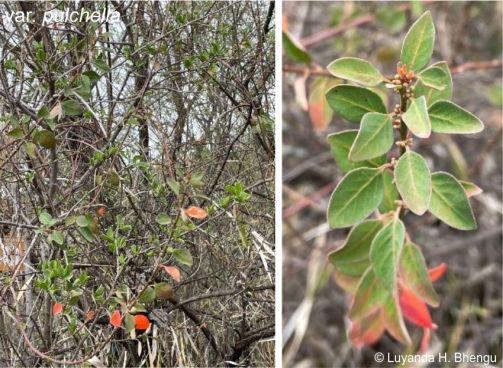
Description
Description
Clutia pulchella is a shrub or small tree and can grow up to 6 m in height. The bark is brown, while new growth has a light brownish-rust colour. The leaves are simple, with each leaf attached individually at alternating nodes. It is deciduous, and its leaves turn bright orange and red in autumn. Clutia pulchella is dioecious, producing unisexual, white, inconspicuous flowers in spring to mid-summer (November to January). The fruit is a 3-lobed, rounded, dehiscent capsule that contains shiny, black, egg-shaped seeds. The fruits dehisce (spontaneously burst) in summer to late autumn (January to May).
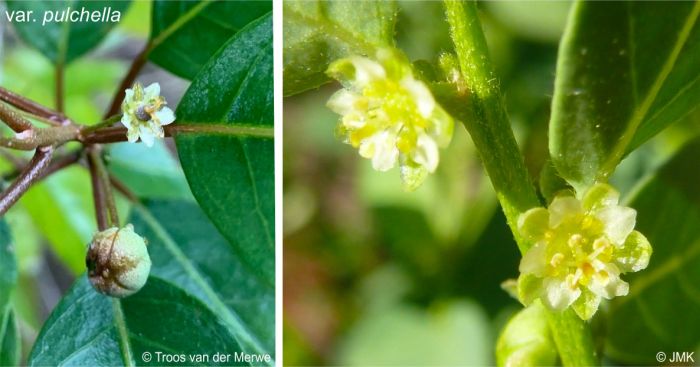
The leaves vary between the varieties.
Clutia pulchella L. var. pulchella leaves have a flattened, ovate-oblong, rounded shape with a blunt-tipped or obtuse apex. The leaves vary in size, ranging from 36 to 60 mm long and 12 to 30 mm wide. The leaves are light green above and blue-green below, with distinct stalks (petioles). The branchlets are covered in raised warts.
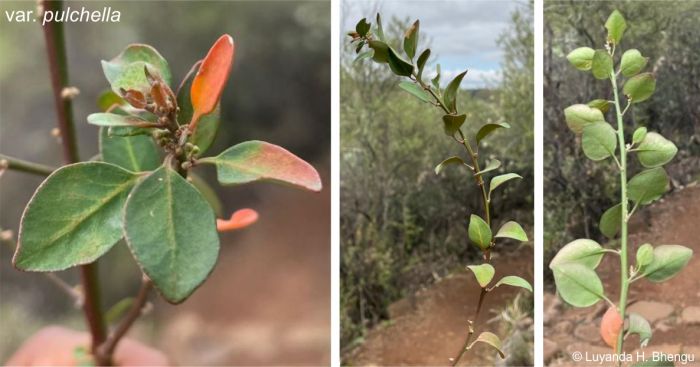
Clutia pulchella L. var. obtusata Sond. has elliptical to ovate shaped leaves with acute to rounded tips. The leaves have reticulate venation, with a visible cream-coloured midrib, and vary in length from 8 to 72 mm, with a width ranging from 6 to 36 mm. The leaves are a light to dark green above, and the underside appears pale green. Leaves have an even and smooth margin throughout their entire edge, with a hairy and velvety texture on the upper surface during their young stage. The lower part of the leaf narrows towards its connection to the stem (base cuneate) and the leaves are sessile (without a petiole). The branchlets are without warts.
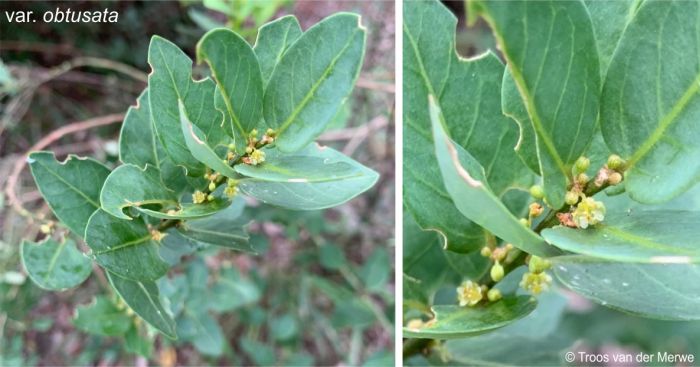
Clutia pulchella L. var. franksiae Prain leaves have long petioles, and elliptic to ovate leaf blades with subobtuse apexes, and a leaf length of up to 25 mm. The leaves have a green to dark green visible midrib and reticulate venation, more prominent on the under side of the blade. The leaf blade is pale to dark green on the upper surface and greyish green below, and often with a velvety texture. Some leaves have visible white-creamy spots. The leaf blade margins are entire, with some showing whitish edges. The branchlets lack warts but have soft, spreading and persistent hairs.
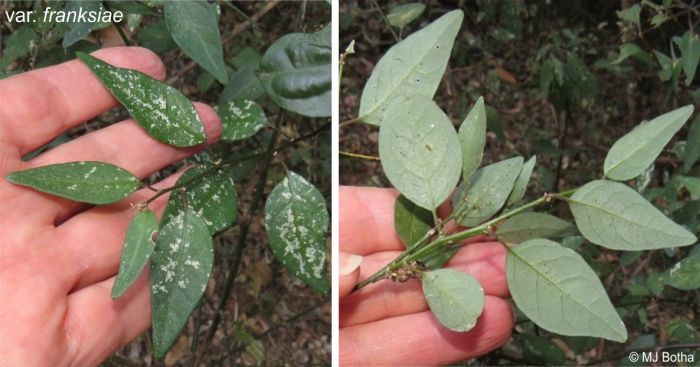
Conservation Status
Status
All three varieties of Clutia pulchella have been assessed as Least Concern (LC) by the Red List of South African Plants.
Distribution and habitat
Distribution description
Clutia pulchella is endemic to southern Africa and is distributed in South Africa, Lesotho, Eswatini, Zimbabwe, Mozambique and Botswana. The variety obtusata is distributed in South Africa, Lesotho, Eswatini, Zimbabwe, Mozambique and Botswana. In South Africa, it can be found in the Eastern Cape, KwaZulu-Natal, Free State and Gauteng, where it is predominant in the Albany Thicket, Savanna and Nama Karoo Biomes, vegetation characterized by arid conditions, growing on rocky hillsides, and along seasonal watercourses. The variety pulchella occurs in South Africa and neighbouring countries Lesotho, Eswatini, Botswana, Zimbabwe and southern Mozambique. In South Africa, this variety is widespread in various biomes such as grassland and savanna, and particularly in vegetation types with karroid scrub, and occurs in the Eastern Cape, Free State, Gauteng, KwaZulu-Natal, Limpopo, Mpumalanga and the Western Cape. The variety franksiae is the sole variety that is endemic to South Africa, occurring in KwaZulu-Natal where it is widespread in in the Savanna and Indian Ocean Coastal Belt Biomes.

Derivation of name and historical aspects
History
The species belongs to the family Peraceae, formerly classified under the Euphorbiaceae family. The classification of Clutia has undergone revisions, and its placement has been reconsidered multiple times which led to changes in tribes and families. The shift from Euphorbiaceae to Peraceae represents a significant transformation in its taxonomic categorization. Johann Friedrich Klotzsch distinguished the family Peraceae (a family of angiosperms) from Euphorbiaceae in 1859, and its distinctiveness was subsequently confirmed by Airy Shaw, an expert on Euphorbiaceae at the Royal Botanic Gardens, Kew.
The genus Clutia was named by Carl Linnaeus (1707–1778) in the 17th century in an honour of Theodorus Augerius Clutius (Outger Cluyt) (1578–1636), a Dutch botanist, horticulturalist, beekeeper and pharmacist, and his father Dirck Outgaertszoon Cluyt (Clutius) (1550–1598) an apothecary and the Curator of the Leiden Botanical Garden. Clutia is native to sub-Saharan Africa and the Arabian Peninsula with approximately 56 species. In South Africa, 40 species under this genus have been recorded.
The specific name pulchella is derived from the Latin word pulchellus, which means 'beautiful’ or ‘charming’. The variety name obtusata, meaning ‘blunt’ or ‘obtuse’, refers to the obtuse apex of the leaf, and franksiae is named for Millicent Franks (1886–1961) a botanical artist and assistant to John Medley Wood at the Natal Herbarium.
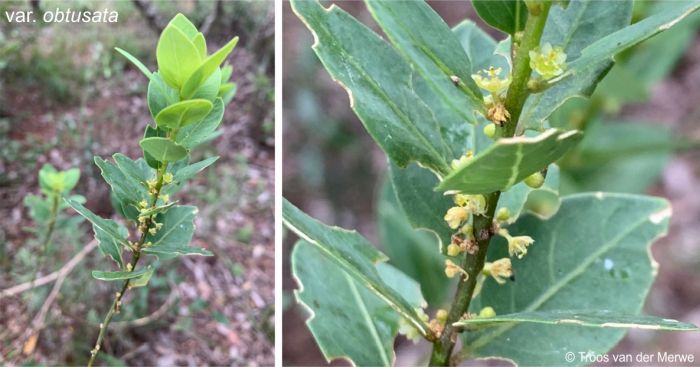
Ecology
Ecology
All three varieties of Clutia pulchella are valued for their role in stabilizing soil and preventing erosion in their natural habitat. Due to their inconspicuous flowers that lack showy petals or nectar they primarily rely on wind for pollination (anemophily). These varieties offer shelter and nesting sites for birds and insects. For example, insects such as the spotted sailor butterfly (Neptis saclava marpessa) and the endangered Heidelberg Opal Butterfly (Chrysoritis aureus) species rely on this plant throughout their life cycle.
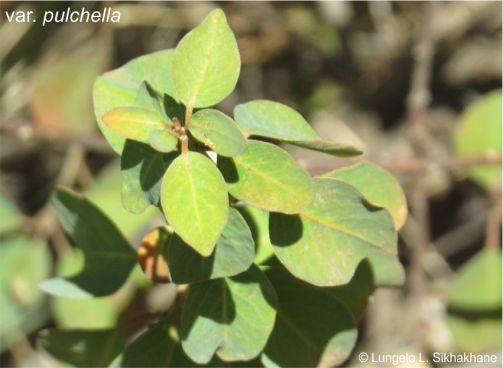
Uses
Use
Clutia pulchella is widely used as an ornamental plant because of the combination of green to dark green and pale to bright red foliage and its bushy appearance that make it suitable for screening. It is also easy to grow, low-maintenance and very tolerant of frost and drought with non-aggressive roots and is suitable for small gardens.
Various plant parts such as leaves, stems, and roots are locally harvested and utilized for medicinal purposes. A hot leaf infusion is consumed to treat stomach aches and diarrhea. Mixing leaves, stems and roots with milk is employed to alleviate children's stomach aches through enemas and can also be used for calves. Furthermore, the ash from the plant's roots is applied to promote the healing of fractures and sprains through scarifications. The plant is also utilized for curing headaches and treating swollen glands (adenoids). The species is also used as a love charm and serves as protection against lightning, hence the popular common name lightning bush.
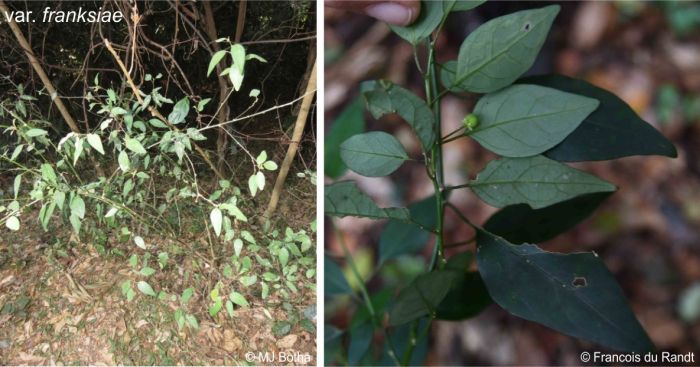
Growing Clutia pulchella
Grow
All the varieties of Clutia pulchella can be propagated by seed, division of mature plants and by cuttings . Collect the seeds from mature fruits and sow in well-drained soil in spring or summer. Mature plants can be lifted and divided into smaller sections , while ensuring that each section has enough roots.
To propagate Clutia pulchella by cuttings, use a young fresh branchlet or stem that is healthy and remove the leaves near the cut end. It is advisable that cuttings should be done during the autumn or winter seasons. It is recommended that cuttings be dipped into rooting hormone to stimulate fast and prolific rooting of cuttings. Prepare a free-draining rooting substrate mix composed of perlite, river sand, compost and fine-milled bark. After filling the tray with the growth medium, plant the cuttings in the substrate at least 2 cm deep. Place the tray in a mist house or greenhouse. In approximately two weeks, under warm weather conditions, the cuttings should develop roots. (R.S.L. Memani pers. comm. 2023)
References
- Boon, R. 2010. Pooley's trees of eastern South Africa, a complete guide. Flora & Fauna Publications Trust, Durban.
- Charters, M.L. 2006–2021. The Eponym Dictionary of South African plants. Published online at http://www.calflora.net/southafrica/1Titlepage.html
- Deysel, R., Myburgh, W.J. & Panagos, M.D. 2017. Fine-scale habitat requirements of the Heidelberg Opal Butterfly (Chrysoritis aureus) in Gauteng and Mpumalanga, South Africa. Bothalia 47(1):10.4102/abc.v47i1.2220
- Dlamini, T. 1996. Pollen morphology and taxonomy of Clutia L. (Euphorbiaceae). Systematics Honours Project, University of Cape Town, Cape Town.
- Grové, N. 2016. Vratjievrugbliksembos en ander Magaliesbergbome. Briza Publications, Queenswood.
- Henning, G. 2018. Chrysoritis aureus J van Rossum. Regional Assessment: Red List of South African Species. SANBI. http://speciesstatus.sanbi.org/assessment/last-assessment/329/. Accessed 18 Oct. 2023.
- Madzinge, A.R. 2021. Taxonomic revision of selected problem groups of the genus Clutia in KwaZulu-Natal, South Africa. Masters Dissertation, University of Johannesburg, Johannesburg.
- Moffett, R. 2010. Sesotho plant and animal names and plants used by the Basotho. Sun Press, Bloemfontein.
- Coates Palgrave, M. 2002. Keith Coates Palgrave Trees of southern Africa, edn 3. Struik, Cape Town.
- Plants of the World Online. Clutia pulchella var. pulchella. https://powo.science.kew.org/taxon/urn:lsid:ipni.org:names:77167936-1. Accessed 17 October 2023.
- Radcliffe-Smith, A. 1992. Notes on African Euphorbiaceae XXVII: Clutia. Kew Bulletin 47(1):111–119.
- Radcliffe-Smith, A. 1996. Clutia pulchella var. obtusata Sond. Flora Zambesiaca 9(4). Accessed via JSTOR Global Plants.
- Raimondo, D., Von Staden, L., Foden, W., Victor, J.E., Helme, N.A., Turner, R.C., Kamundi, D.A. & Manyama, P.A. (eds) 2009. Red list of South African plants. Strelitzia 25. South African National Biodiversity Institute, Pretoria.
- Retief, E. & Meyer, N.L. 2017. Plants of the Free State inventory and identification guide. Strelitzia 38. South African National Biodiversity Institute, Pretoria.
- South African National Biodiversity Institute. Botanical Database of Southern Africa (BODATSA) Clutia pulchella L. https://posa.sanbi.org/. Accessed 16 November 2023.
- South African National Biodiversity Institute. Vegetation of SA. https://pza.sanbi.org/vegetation. Accessed 16 November 2023.
- Thompson, D. & Edwards, T. 2001. Breeding biology, resource partitioning, and reproductive effort of a dioecious shrub, Clutia pulchella L. (Euphorbiaceae). Plant Systematics and Evolution 226:13–22.
- Treeshop. Clutia pulchella, Lightning-bush trees for sale. https://www.indigenoustrees.online/clutia-pulchella-lightning-bush. Accessed 17 October 2023.
- Useful Tropical Plants Database. Clutia pulchella L. Peraceae. https://tropical.theferns.info/viewtropical.php?id=Clutia+pulchella. Accessed 08 October 2023.
- Wikipedia. Peraceae. https://en.wikipedia.org/wiki/Peraceae. Accessed 16 November 2023.
Credits
Lungelo L. Sikhakhane and Loyd R. Vukeya
Free State National Botanical Garden
April 2024
Acknowledgements: The authors thank Lufuno Nenungwi (Senior Horticulturist) and Luyanda H. Bhengu (Horticulturist Intern) at the Free State NBG for taking their time to review the article and Luyanda for also taking many of the images; Dr. Robert H. Archer, Control Agricultural Scientist at the National Herbarium, Pretoria, for sharing his knowledge and opinion about species distribution and taxonomy; Dr. Francois du Randt, for sharing his knowledge and images of Clutia pulchella var. franksiae via I-Naturalist; Mr. M.J. Botha, Mahomed Desai and Troos van der Merwe for sharing their images of Clutia pulchella via iNaturalist; and JMK for sharing their images via Wikipedia.
Plant Attributes:
Plant Type: Shrub, Tree
SA Distribution: Eastern Cape, Free State, Gauteng, KwaZulu-Natal, Limpopo, Mpumalanga, Western Cape
Soil type: Sandy, Loam
Flowering season: Spring, Early Summer
PH: Acid, Neutral
Flower colour: White, Cream
Aspect: Full Sun, Morning Sun (Semi Shade), Afternoon Sun (Semi Shade)
Gardening skill: Easy
Special Features:
Horticultural zones










Rate this article
Article well written and informative
Rate this plant
Is this an interesting plant?
Login to add your Comment
Back to topNot registered yet? Click here to register.